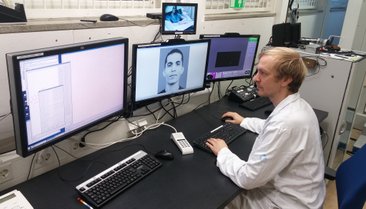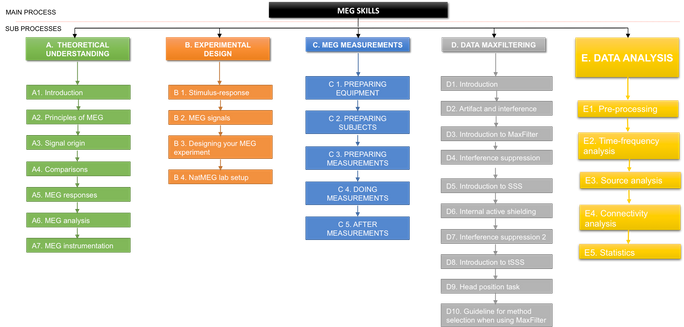NatMEG driver's license course
Learn the basics of doing a MEG experiment at the NatMEG facility.
To do MEG measurements on your own at the NatMEG facility, you need to take our driver's license training. We arrange courses regularly, but also on request if there are enough attendees interested.
The course is aimed at researchers at all stages who are interested in or plan to run a MEG study. It is mandatory for all who will use the NatMEG facility, including PI, PhD students, and assistants helping during data collection – as long as they will have to work in the lab. Researchers who are either attached to an ongoing project or starting a new project at NatMEG will be given priority when signing up.
Future NatMEG driver's license dates
There are currently no planned driver's license courses, due to the COVID19 situation. On-site training will instead be arranged on a projet-to-project basis as needed and in accordance with the guidelines issued by KI for laboratory training. For questions send an email to megdriverslicense@natmeg.se.
The goal of the driver's license course
The driver's license course has three main components. The first is to get theoretical knowledge of MEG, and a basic understanding of what MEG is and what you can measure using MEG. The second part is hands-on training in the MEG lab that will get you acquainted with the MEG lab, and giving you the fundamentals in making your own MEG recordings at the NatMEG facility.
The course will not cover how to analyze MEG data, nor issues regarding specific research questions. The goal of the NatMEG Driver's License Course it to learn the basics of MEG instrumentation and the skills to do quality measurements at the NatMEG facility.
MEG driver's license overview
Part 1: Theoretical background
Homework in preparation for the on-site course. No later than one day before the on-site training, you should go through the following video lectures. When you do this, please make notes, in particular about things appearing unclear to you. Expect a short test on-site during Part 2.
You find the video lectures for the NatMEG Driver's License Corse here:
- Introduction to MEG, theory, and practice (by Lauri Parkkonen).
- MEG data preprocessing by MaxFilter (by Liisa Heller).
- Electrodes and HPIs placement (by Fanny Lachat).
Part 2: On-site training
Part 2 is the whole day (10:00-16:00) course, where you get to train the workflow of running a typical MEG experiment in our lab. We go through all the steps following a research participant from 'hello' to 'goodbye' preparing and performing recordings in the lab.
The day is divided into two parts. In the morning, we start with a brief overview of the MEG facility to learn to navigate in the lab and get an overview of equipment, including hands-on exercises in setting up and preparing for running an experiment.
After the lunch break, we continue with the hands-on exercises. First, how to prepare subjects with EOG, ECG, and HPI coils before recording MEG and learn to assure adequate quality of preparation before recording begins. Then we will do one or two MEG recordings from start to end. Finally, we will demonstrate running MaxFilter and upload data to the server.
How to register?
If you are interested in taking the course, send an email to natmeg@ki.se, Please include your name, email, affiliation, and a short message about why you wish to take the course.
The NatMEG driver's license course is free of charge. There is a limited amount of seats available for the course. Researchers who are either attached to an ongoing project or starting up a new project at NatMEG will be given priority when signing up.
Suggested reading material
There is no mandatory reading material for the driver's license course. Below you will find a few recommendations to get started with learning about MEG and doing MEG measurements.
About MEG and good practice:
-
Pernet, et al. (2018). Best Practices in Data Analysis and Sharing in Neuroimaging using MEEG. OSFpreprints.
- Gross, et al. (2013). Good practice for conducting and reporting MEG research. NeuroImage.
About MaxFilter:
- Taulu et al. (2005). Applications of the signal space separation method. IEEE TRANSACTIONS ON SIGNAL PROCESSING
Analysis toolboxes
The driver's license course will not cover how to analyze MEG data (do, however, see upcoming events and workshops at NatMEG). We do recommend to get an understanding of analysis methods before getting started with your research. Below you will find links to suggested analysis toolboxes for analyzing MEG data. Most have well-documented tutorials to help getting started.
For more information and how to get started, see the web pages of the individual toolboxes:
See also our online lectures and MEG topics (Only a tiny part of this will be covered in the driver's license course).

